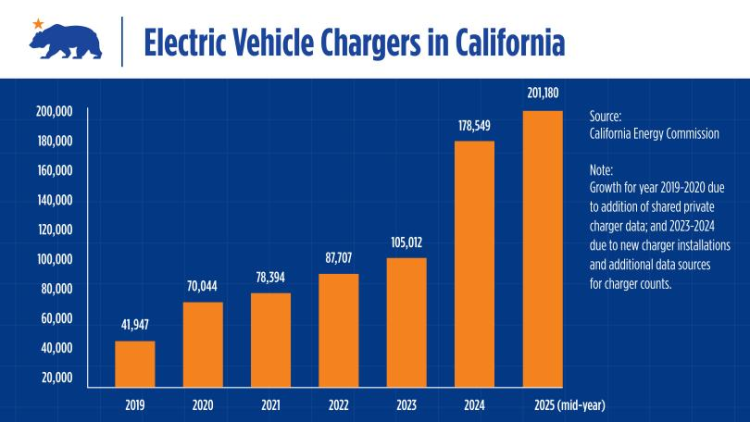Today (Sept 24), Governor Gavin Newsom announced that there are now 201,180 fully public and shared electric vehicle (EV) charging ports. This is 68% more EV charger ports than the number of gasoline nozzles statewide, according to the California Energy Commission (CEC).
California's growing number of publicly available EV chargers can be found at locations that are fully publicly accessible, like grocery stores, park and ride lots, and even gas stations, whereas shared chargers can be found at apartment complexes, workplaces, doctors' offices, sports facilities, and other parking areas that may have some level of restricted access. This statewide network of public and shared chargers is in addition to the estimated 800,000 EV chargers installed in single-family homes.
"With this expanding public network, EV chargers are becoming ubiquitous in California," said CEC Commissioner Nancy Skinner. "Our goal is to make driving an EV a no-brainer choice for Californians. They are fun to drive, never need an oil change, don't cause smog, and it's getting easier to charge your vehicle with public EV infrastructure."

It has never been a better time to buy and drive an EV in California. Federal incentives of up to $7,500 are still available through the end of September, and thanks to the state's ever-expanding charger network, 94% of Californians live within 10 minutes of an EV charger.
The majority of California's public chargers are Level 2, which will provide 25-35 miles of range in about an hour of charging. A growing number are direct current fast chargers (DCFC), which charge EVs much faster, providing almost a full charge in 15 to 45 minutes. Since the CEC's last count, DCFC public and shared charging ports are up 14% and Level 2 charging ports are up 25%.
FEDERAL ZEV INCENTIVES END SEPTEMBER 30
With federal incentives ending on Sept. 30, 2025, the time to buy a zero-emission vehicle (ZEV) is now. Tax credits up to $7,500
are available for purchase or lease of eligible new ZEVs, which include EVs and hydrogen-fueled vehicles, and up to $4,000 for eligible used ones. Federal incentives for at-home charging and associated battery storage are also available, up to $1,000. Find the right vehicle for you at ElectricForAll.org.
CALIFORNIA IS CHARGING AHEAD
Each day, more chargers come online in the Golden State, improving the driving experience for EV drivers.
California state agencies are working hard to speed up EV charger installation and plan for increasing grid demand. This includes:
- Providing grant funds that support publicly accessible, workplace and at-home EV charging installations, including in multi-family complexes.
- Prioritizing shovel-ready DCFC charging installations for the funding incentives available through the CEC's grant solicitation programs.
- Developing the ZEV Infrastructure Plan, which provides critical guidance for meeting California's zero-emission transportation goals.
- Establishing EV charger reliability standards.
State agencies recently published a report
in response to Governor Gavin Newsom's executive order reaffirming the state's commitment to ZEV adoption. While the federal government is running away from ZEVs, California is charging ahead in the fight for clean air for all.
California is tearing down barriers to ZEV adoption and providing financial and other assistance to speed up EV charger deployment, including in low-income areas and rural communities.
MAKING PROGRESS IN THE MEDIUM- AND HEAVY-DUTY SECTOR
The CEC also announced today that there are 20,093 charging and hydrogen fueling points for medium- and heavy-duty (MDHD) zero-emission vehicle (ZEV) vehicles across the state. This is an increase of 3,766 (23%) since the last update in February 2025.
While trucks total just six percent of vehicles on California's roads, they account for over 35 percent of the state's transportation emissions and a quarter of the state's on-road greenhouse gases. Investments in MDHD ZEV stations and infrastructure will result in cleaner air and fewer cases of asthma near major transportation corridors.
Deploying MDHD ZEVs and infrastructure as quickly as possible will benefit all Californians today and for future generations.
About the California Energy Commission
The California Energy Commission is the state's primary energy policy and planning agency. It has seven core responsibilities: advancing state energy policy, encouraging energy efficiency, certifying thermal power plants, investing in energy innovation, developing renewable energy, transforming transportation, and preparing for energy emergencies.









